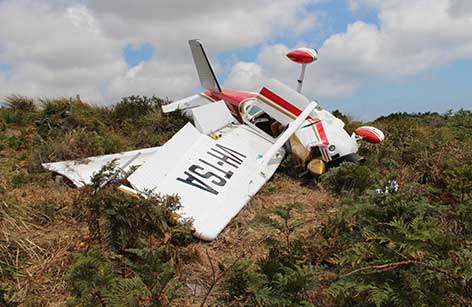A fatal collision with terrain at a private airfield has highlighted the importance of obtaining all relevant information about local wind conditions before commencing an approach.

The accident occurred on 20 January 2018, when a Cessna 182 carrying a pilot and passenger was completing the journey from The Vale Airstrip to a private airfield at Tomahawk, Tasmania. The pilot conducted a number of orbits and then approached the runway.
The pilot was unaware, however, that his choice of approach direction exposed the aircraft to a tailwind that significantly increased the groundspeed on final approach. This resulted in insufficient landing distance. Additionally, the final approach was not stable. In combination with the tailwind, this resulted in the aircraft coming in too high and fast.
The aircraft touched down more than halfway along the runway – well beyond the runway threshold – and it bounced several times. In response, the pilot commenced a go-around, but the aircraft collided with a tree beyond the end of the runway, and it impacted the ground. The passenger was fatally injured, and the pilot sustained serious injuries. The aircraft was substantially damaged.
The investigation found that the pilot had not identified the direction of the local surface wind, although it was forecast. There was no windsock at the airfield, but there were a number of other means by which the pilot could have assessed the wind prior to commencing the approach.
If a safe landing cannot be assured, the pilot should abort the landing and go-around early.
ATSB Executive Director Transport Safety, Mr Nat Nagy said the investigation found that the selected landing direction meant that the aircraft had an increased tailwind and groundspeed on approach.
“The investigation also found that the final approach path was unstable,” Mr Nagy said. “What that meant was that the aircraft was both high and fast when it was coming into land which meant it landed well down the runway and bounced during that landing.”
The investigation also found that the go-around was initiated at a point from which there was insufficient distance remaining for the aircraft to climb above the tree at the end of the runway in the landing flap configuration and tailwind conditions.
“The ATSB’s safety message out of this investigation is to remind all pilots that they should determine the local weather conditions, including wind direction and strength, prior to commencing an approach,” Mr Nagy said. “Most importantly, if a safe landing cannot be assured, the pilot should abort the landing and go-around early.”
Read the report: Collision with terrain involving Cessna 182, VH-TSA, at Tomahawk, Tasmania, on 20 January 2018


